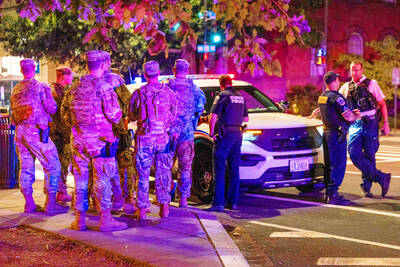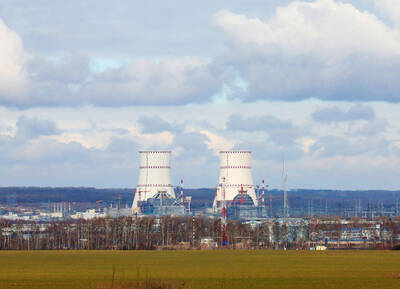The Sculptor galaxy is similar in many respects to the Milky Way. It is about the same size and mass, with a similar spiral structure, but while it is impossible to get a full view of the Milky Way from the vantage point of Earth, because we are inside it, Sculptor is perfectly positioned for a good look.
Astronomers on Wednesday did just that, releasing an ultra-detailed image of the Sculptor galaxy obtained with 50 hours of observations using one of the world’s biggest telescopes, the European Southern Observatory’s Very Large Telescope in Chile.
The image shows Sculptor, also called NGC 253, in about 4,000 colors, each corresponding to a wavelength in the optical spectrum.

Photo: Reuters
Because various galactic components emit light differently across the spectrum, the observations are providing information at unprecedented detail on the inner workings of an entire galaxy, from star formation to the motion of interstellar gas on large scales. Conventional images in astronomy offer only a handful of colors, providing less information.
The researchers used the telescope’s Multi Unit Spectroscopic Explorer (MUSE) instrument.
“NGC 253 is close enough that we can observe it in remarkable detail with MUSE, yet far enough that we can still see the entire galaxy in a single field of view,” said astronomer Enrico Congiu, a fellow at the European Southern Observatory in Santiago, and lead author of the research being published in the journal Astronomy & Astrophysics.
Sculptor is about 11 million light-years from Earth, making it one of the closest big galaxies to the Milky Way. A light-year is the distance light travels in a year, 9.5 trillion kilometers.
Like the Milky Way, it is a barred spiral galaxy, meaning it has an elongated structure extending from its nucleus, with spiral arms extending from the ends of the bar. Its diameter of about 88,000 light-years is similar to the Milky Way’s, as is its total mass.
One major difference is Sculptor’s rate of new star formation, estimated to be two to three times greater than that of the Milky Way.
Nearly 30 percent of this star formation is happening near the galaxy’s nucleus in what is called a starburst region, as revealed in colorful emissions shown in the new image.
“Since the light from stars is typically bluer if the stars are young or redder if the stars are old, having thousands of colors lets us learn a lot about what stars and populations of stars exist in the galaxy,” study coauthor and Heidelberg University astronomer Kathryn Kreckel said.
The researchers marveled at the scientific and aesthetic value of the new view of Sculptor.
“I personally find these images amazing,” Congiu said. “What amazes me the most is that every time I look at them, I notice something new — another nebula, a splash of unexpected color or some subtle structure that hints at the incredible physics behind it all.”

Philippine President Ferdinand Marcos Jr has fired his national police chief, who gained attention for leading the separate arrests of former Philippine president Rodrigo Duterte on orders of the International Criminal Court and televangelist Apollo Carreon Quiboloy, who is on the FBI’s most-wanted list for alleged child sex trafficking. Philippine Executive Secretary Lucas Bersamin did not cite a reason for the removal of General Nicolas Torre as head of the 232,000-member national police force, a position he was appointed to by Marcos in May and which he would have held until 2027. He was replaced by another senior police general, Jose

STILL AFLOAT: Satellite images show that a Chinese ship damaged in a collision earlier this month was under repair on Hainan, but Beijing has not commented on the incident Australia, Canada and the Philippines on Wednesday deployed three warships and aircraft for drills against simulated aerial threats off a disputed South China Sea shoal where Chinese forces have used risky maneuvers to try to drive away Manila’s aircraft and ships. The Philippine military said the naval drills east of Scarborough Shoal (Huangyan Island, 黃岩島) were concluded safely, and it did not mention any encounter with China’s coast guard, navy or suspected militia ships, which have been closely guarding the uninhabited fishing atoll off northwestern Philippines for years. Chinese officials did not immediately issue any comment on the naval drills, but they

POWER CONFLICT: The US president threatened to deploy National Guards in Baltimore. US media reports said he is also planning to station troops in Chicago US President Donald Trump on Sunday threatened to deploy National Guard troops to yet another Democratic stronghold, the Maryland city of Baltimore, as he seeks to expand his crackdown on crime and immigration. The Republican’s latest online rant about an “out of control, crime-ridden” city comes as Democratic state leaders — including Maryland Governor Wes Moore — line up to berate Trump on a high-profile political stage. Trump this month deployed the National Guard to the streets of Washington, in a widely criticized show of force the president said amounts to a federal takeover of US capital policing. The Guard began carrying

Ukrainian drone attacks overnight on several Russian power and energy facilities forced capacity reduction at the Kursk Nuclear Power Plant and set a fuel export terminal in Ust-Luga on fire, Russian officials said yesterday. A drone attack on the Kursk nuclear plant, not far from the border with Ukraine, damaged an auxiliary transformer and led to 50 percent reduction in the operating capacity at unit three of the plant, the plant’s press service said. There were no injuries and a fire sparked by the attack was promptly extinguished, the plant said. Radiation levels at the site and in the surrounding